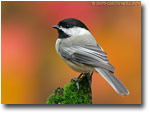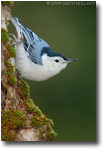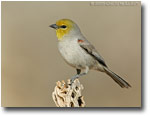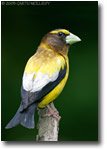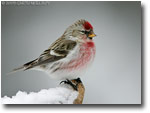Bird photography is one of the most challenging types of nature photography. Wild birds are often difficult to approach and they never stay in one place for long. Due to the small size and fast-paced behavior of songbirds, large telephoto lenses are often required, and expensive, fast-focusing camera bodies are usually needed. Fortunately, this is not always the case. Your own backyard can serve as a personal studio in which you can be in control of your subjects and obtain beautiful photos. This is one of the very few situations where eye-catching, close-up bird photography is possible without extravagant photo equipment. The following is a how-to guide to photographing birds in your backyard and these tips will help you achieve bird photos that you have always wanted to get, but never knew how.
Setting Up Feeders
|
The most important consideration in choosing a location for bird feeders is lighting. Most bird photographers choose direct front lighting for shooting their subjects. Birds have lots of color and fine feather detail and direct front lighting shows the beauty of birds in a brilliant manner. The most important thing to remember when considering lighting is to always point your shadow at the bird. This will ensure that your subject is evenly lit with no shadows.
When hanging feeders for bird photography, avoid placing them too close to your house or too close to the edge of the woods. Both these situations can block light and make it difficult to obtain stunning pictures. The best light for bird photography is early in the morning and late in the afternoon. By placing the feeders in an open area, you will have more opportunity with the best light. Be careful not to place the feeders in an area that doesn’t provide enough cover. I place my feeders about 15-20 feet from the edge of a wooded area. This gives the birds a safe area to travel to and from the feeders and provides a nice background in my images.
Fewer feeders produce more photo opportunities than many feeders. The idea is to create a food source that lots of birds are using. Choose one small feeder per food source. This in essence will create a waiting line for the feeder and force birds to perch and wait. For suet lovers, set up a separate feeding station. Digging a hole in the ground and “planting” a dead, moss-covered tree works very well for woodpeckers and nuthatches. Position the suet on the backside of the tree so it will not be in sight of the camera. Woodpeckers will often pause before and after feeding on suet, thus offering a few additional photo opportunities before departing.
Selecting the Ideal Perch
Perch selection is critical to the natural feel of your photographs. Perches should look natural and not “set-up.” Avoid manmade objects such as processed lumber, metal, or plastic. Instead, walk around your yard and find fallen twigs, small branches, raspberry or rose stalks, or wild plants bearing berries (winterberry holly or bittersweet work well). It’s very important to choose a perch that is natural for the species being photographed. Be very careful when positioning a pruned perch for photography. An obvious snipped or torn branch in a photo is not pleasing to the eye.
Think about the species that will be using each perch - you do not want to overpower the bird with a perch. For smaller birds, such as chickadees, goldfinches, and titmice, choose a thin perch, perhaps ¼ to ½ an inch in diameter. For larger birds, such as blue jays and cardinals, a perch of ½ to 1 inch in diameter will look pleasing in a photo.
Carefully position the perches close to the feeders. Remember, the fewer perches you have, the better. You want to ‘force’ the birds to land on a particular perch. Placing a perch one foot under or next to a feeder will provide suitable waiting space or a jumping-off point to the feeder for a hungry bird. It’s also very important to place the perch at the appropriate angle. A good starting point is to mount the perch vertically and then push it directly away from you at a 45-degree angle. This will ensure a profile of the bird. If you want a head-on shot position the perch at a 45-degree angle horizontal to your position.
Before you start snapping photos of birds, it’s important to look at your perch set-up through the viewfinder. What looks good to your eye may not look good through the camera. As you look through the viewfinder, make sure the background is a pleasing color, the perch is at a good angle, and there are no unwanted objects in the frame. Always keep an eye out for new and interesting perches and replace your perches often. If you use the same perch over and over, all your images will look the same.
Desirable Camera Equipment
Most birds that visit feeding stations are quite tame and will tolerate a human very close to their food source. A lens in the 200-300mm range (especially when combined with a digital camera or teleconverters) can produce frame-filling images with these cooperative subjects. Using a tripod will greatly aide in obtaining sharp images. It will also allow you to set the camera to a certain point on a perch so you will be ready when a bird lands. Always remember to pre-focus on the perch to cut down on the time it takes to obtain focus.
Being comfortable is also important. Sitting low in a lawn chair with your camera set up in front of you decreases your profile substantially and will allow you to photograph for extended periods comfortably. Movement is your biggest foe when it comes to birds. If you’re using a short telephoto lens, a bag blind or some camouflage material draped over yourself is also a good idea.
With a little strategy, backyard bird photography can be very rewarding. It is a unique form of wild bird photography and by following the advice above, you can be on your way to producing appealing, natural looking bird images. Do not be afraid to experiment with different perches and set-ups - the more variety you have with food sources and perches, the more species you will be able to photograph. You will be amazed by the interesting songbird images that you can produce in your own backyard!
GM-NPN 0459
Comments on NPN bird photography articles? Send them to the editor.
Garth McElroy is a full-time nature photographer specializing in birds. He is from the rural state of New Hampshire and has always had a strong passion for birds and photography. His images have appeared in many publications and have been used by several private organizations. Garth's photos can be found on his website, www.featheredfotos.com and in his online portfolio.
